Takegashima Shrine
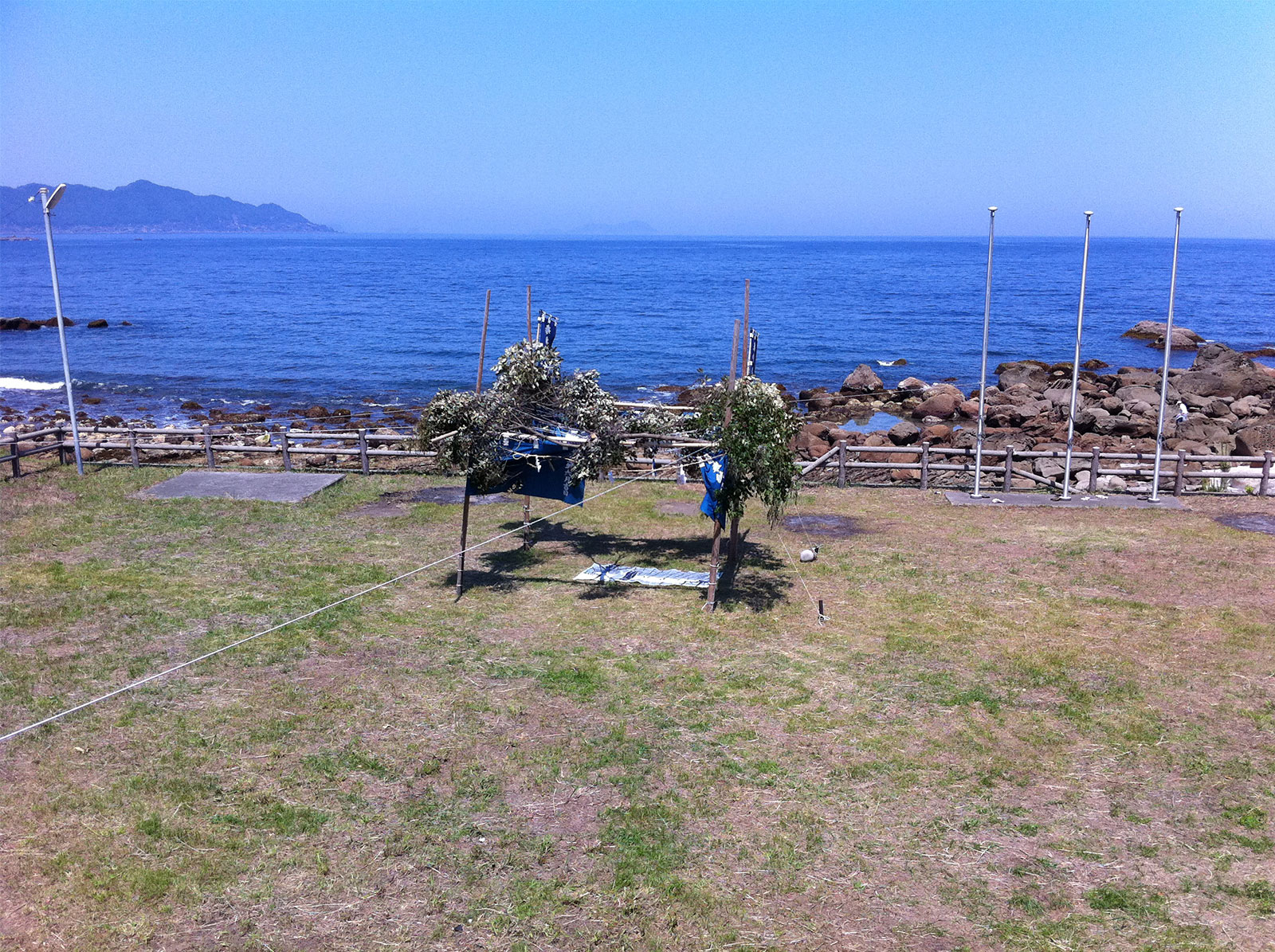
Takegashima Shrine Festival
Takegashima At Takegashima Shrine, fishermen and their families often visit to pray for maritime safety and big catches of fish to Kunitsune-tachinomikoto, Okuninomikoto, and Kotoshironomikoto, who are the enshrined deities. Festivals are held three times a year: the Haru Matsuri, also called the Hatsu Matsuri meaning “first festival”, is held on January 16 of the lunar calendar. The main annual festival, also called the Rei Matsuri, is held on April 16 of the lunar calendar, and the summer festival is held on June 16 of the lunar calendar. The shrine is managed by a total of six people: five palace representatives who serve two-year terms and a general representative who is responsible for the overall management of the shrine. In addition, there is a representative who is chosen every year to be the toya, or the main organizer who is responsible for the festivals and events.
At the Hatsu Matsuri (first festival) and the Natsu Matsuri (summer festival), the priest performs the ritual at the hall of worship, and then goes from house to house on the island to offer prayers. The Rei Matsuri, held on April 16th of the lunar calendar, or May of the new calendar, attracts not only all the residents of Takegashima, but also fishermen from all over the Kaibe County area who gather for the lively event called "Hamainuri," in which a mikoshi shrine is carried out in a stampede of people.
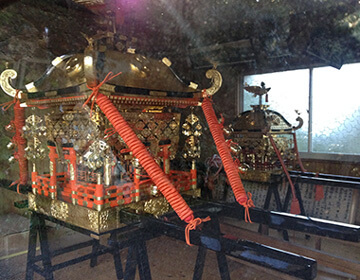 The Rei Matsuri begins at 1:00 p.m. immediately after the Shinto rituals that take place in the hall of worship. The Shinto priest carries over the Goreiyo from the main shrine to the mikoshi shrine, and the procession of the mikoshi shrine to the Otabisho begins. The original order of the procession is: tengu (goblins), narrow box, firearms, gold coins, Ebisu masks, miko (shrine maidens), streamers, drums, salt purification, and then the mikoshi shrine. The mikoshi is carried by about 12 young men. Each of the two handles, one in front and one behind, is carried by two people, and each handle is connected by a rope, with one person holding the rope. The portable shrine is carried while these young people cheer, "Chosaja!” and the mikoshi is then carried down the stairs away from the worship hall, out into the plaza, and paraded around. The crowd then goes down to the beach and into the sea where they sometimes submerge the mikoshi into the water. The mikoshi is then lifted onto the land and carried to the sacred palaquin called the “otabisho” at the beach on the east coast of the island, they put the mikoshi into the sea again.
The Rei Matsuri begins at 1:00 p.m. immediately after the Shinto rituals that take place in the hall of worship. The Shinto priest carries over the Goreiyo from the main shrine to the mikoshi shrine, and the procession of the mikoshi shrine to the Otabisho begins. The original order of the procession is: tengu (goblins), narrow box, firearms, gold coins, Ebisu masks, miko (shrine maidens), streamers, drums, salt purification, and then the mikoshi shrine. The mikoshi is carried by about 12 young men. Each of the two handles, one in front and one behind, is carried by two people, and each handle is connected by a rope, with one person holding the rope. The portable shrine is carried while these young people cheer, "Chosaja!” and the mikoshi is then carried down the stairs away from the worship hall, out into the plaza, and paraded around. The crowd then goes down to the beach and into the sea where they sometimes submerge the mikoshi into the water. The mikoshi is then lifted onto the land and carried to the sacred palaquin called the “otabisho” at the beach on the east coast of the island, they put the mikoshi into the sea again.
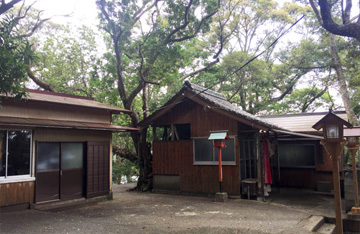 Then, the priest gives a congratulatory speech at the beach. All the Ujiko (guardians of the shrine) and islanders, from the elderly to the children, pass under the portable shrine. There are six Ujiko for Takegashima, and they are chosen through discussion. Finally, the mikoshi is carried to the hall of worship at Takegashima Shrine, the Goryo-dai is returned from the mikoshi to the main shrine, and the festivities come to an end. The mysterious ritual of walking across the sea while carrying a deity has been handed down from ancient times to the present day. This act, also known as the "Kaichu Mikoshi," is thought to have had important religious significance because the sacred mikoshi shrine, in which the deity is believed to reside, was deliberately placed into the sea.
Then, the priest gives a congratulatory speech at the beach. All the Ujiko (guardians of the shrine) and islanders, from the elderly to the children, pass under the portable shrine. There are six Ujiko for Takegashima, and they are chosen through discussion. Finally, the mikoshi is carried to the hall of worship at Takegashima Shrine, the Goryo-dai is returned from the mikoshi to the main shrine, and the festivities come to an end. The mysterious ritual of walking across the sea while carrying a deity has been handed down from ancient times to the present day. This act, also known as the "Kaichu Mikoshi," is thought to have had important religious significance because the sacred mikoshi shrine, in which the deity is believed to reside, was deliberately placed into the sea.
Today, due to the depopulation of Takegashima and the lack of young people to carry the mikoshi, the Hamaneri event was canceled in 2017. Given that the event had already been canceled six times before, its continuation in the future is in jeopardy. Mr. Shimazaki, who serves as the town councilor of Kaiyo-cho and is also the general representative of the shrine, said, "Many people look forward to this traditional event on the island. I would like to work with other representatives and the chief priest of the shrine to plan out some countermeasures so we can do this event next year," he said.
The ancient shrine rock formation that serves as the dwelling for the deity of Takegashima
Along the southern coast of Uraiso, there are three rows of huge boulders with a thin wall-like protrusion, and a cave that exists in between them. The cave is also called "Kogu" (an ancient shrine) because the local deity Fudo-san has been enshrined there since ancient times, and the shrine is where it used to reside. At the top of the huge rock formation, which looks like a wall of rock that is about 3 meters thick, there is a rounded boulder that appears to have been placed by human hands, and it has become the sacred rock seat and an object of worship.
About 100 meters away from the mainland, there is a cave where a deity has been worshiped since ancient times, and there is a huge stone that is called the "Wall of Rock". The deity was worshiped at the top of the rocky area, so there must have been some special reason to regard Takegashima as a sacred place in ancient times. Because there was a special reason to pray to the deity there, even across the sea, the rocky place consisting of megaliths came to be called Komiya or an “ancient palace”.
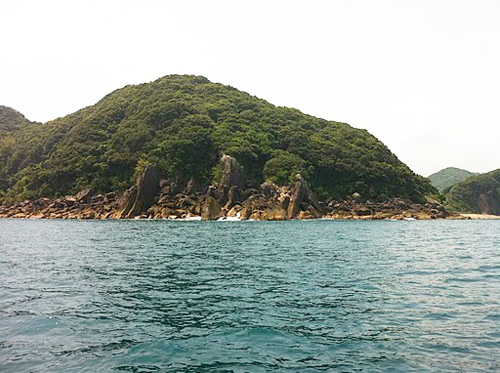 Wall of Rocks Lined up in 3 Columns on the Eastern Shore of TakegashimaThe sacred object of the Takegashima Shrine is a huge rock formation located on the eastern side of the island, adjacent to the ancient shrine on the Pacific coast. There, huge rock walls boasting unusual shapes are lined up in a row, and the three megaliths can be seen far from the distant sea. The majestic appearance of these walls boasts a unique shape and scale that is not seen in Japan, and the top of the central rock is a giant stone that is the symbol of the rock formation. The position and shape of these megaliths seem to be aligned too perfectly to think of them as an occurrence in nature. Rather, it seems more likely to think that the deity was placed at the top of the rock by human hands in ancient times and then performed ritual activities around it. The place has come to be regarded as the sacred site of Takegashima, and many people have arrived at its shore to worship the gods.
Wall of Rocks Lined up in 3 Columns on the Eastern Shore of TakegashimaThe sacred object of the Takegashima Shrine is a huge rock formation located on the eastern side of the island, adjacent to the ancient shrine on the Pacific coast. There, huge rock walls boasting unusual shapes are lined up in a row, and the three megaliths can be seen far from the distant sea. The majestic appearance of these walls boasts a unique shape and scale that is not seen in Japan, and the top of the central rock is a giant stone that is the symbol of the rock formation. The position and shape of these megaliths seem to be aligned too perfectly to think of them as an occurrence in nature. Rather, it seems more likely to think that the deity was placed at the top of the rock by human hands in ancient times and then performed ritual activities around it. The place has come to be regarded as the sacred site of Takegashima, and many people have arrived at its shore to worship the gods.
Later on, Kukai, or Kobo Daishi, who was born and raised in Sanuki, Shikoku, opened his spiritual sight on Cape Muroto at the age of 19. He must have noticed the existence of Takegashima on his journey by boat along the east coast of Shikoku to Cape Muroto. Not only was there an ancient smoke signal tower, but there was also a series of three strangely shaped rocks jutting out from the island's eastern shore. Kukai, who had studied the topography of the area around Takegashima noted that there was an ancient ritual site there, and he personally worshiped at Takegashima and considered it to be important holy grounds. Kukai himself planted bamboo in the central part of the island, and it is thought that this is the reason why the island came to be called "Takegashima".
What is the history behind Takegashima Shrine?
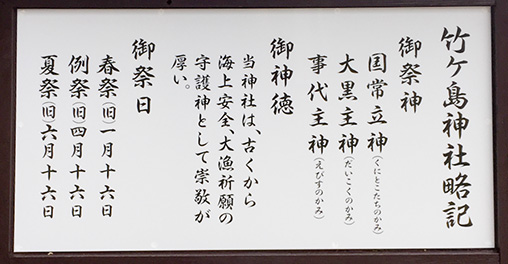 The history of the island shrine is unknown, but there is a local legend that says a ship in distress was saved by a deity. On one stormy night, a ship in distress off the coast of Takegashima spotted a light in the distance and they used the light as a guide to make it to the shore unharmed. From that point on, the people of Takegashima have always gathered at the shrine on the rocks on the eastern shore of the island to pray to receive divine blessings for safe voyages and a great catch of fish. In later times, the Takegashima Shrine was built at its present location.
The history of the island shrine is unknown, but there is a local legend that says a ship in distress was saved by a deity. On one stormy night, a ship in distress off the coast of Takegashima spotted a light in the distance and they used the light as a guide to make it to the shore unharmed. From that point on, the people of Takegashima have always gathered at the shrine on the rocks on the eastern shore of the island to pray to receive divine blessings for safe voyages and a great catch of fish. In later times, the Takegashima Shrine was built at its present location.
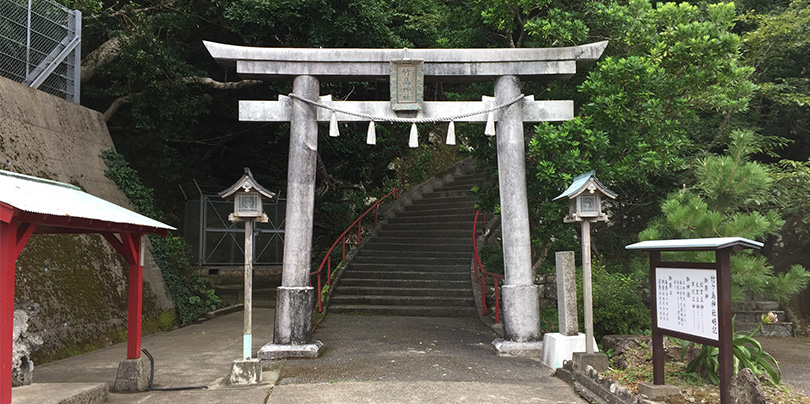
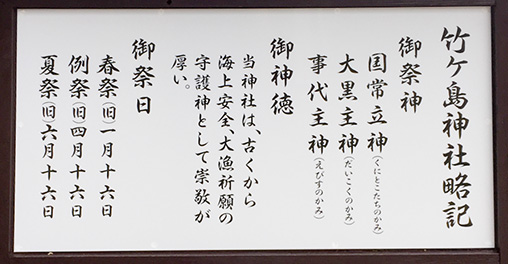
Before that time, it is assumed that in ancient times that gods were worshiped on Takegashima, and the relationship between nature, gods, and humans was considered essential for survival. Today, a bamboo grove grows thickly in the center of the island from which there are seven-tiered terraces that were built by human hands facing east and west toward the Bishago rock shore on the western coast. On the vernal equinox and the autumnal equinox, sunlight shines from the central part of the island toward the center of the bamboo grove. These occurrences cannot be considered coincidences. The sun, the bamboo grove, the rock, and the seven terraces all seem to offer a glimpse into the careful planning that went into this sanctuary.
For the ancient Israelites who arrived from Western Asia, the rock was also a symbol of God. In fact, the Israelites used the word "Tsu," meaning "rock," for the word "god," in ancient times. The rock was considered to be a god. Therefore, the island of rocks that suddenly appeared out of the sea was considered to be a truly holy place. Thus, Takegashima must have been a sacred place because of its uniqueness as a rocky island.
The existence of Takegashima Shrine and its ancient hidden sanctuary in the South Sea, is still little known to this day. It is my sincere hope that this island, full of dreams and ancient romance, will be preserved as a beautiful and valuable place in which tourists can visit forever.
Ancient Ceremony on Takegashima Celebrating the New Year
Lastly, here is an excerpt from the village history about the New Year ritual of burning the sagicho decorations.
On Takegashima Island, pine decorations and sacred paper lanterns are hung in celebration of the Little New Year festivities that take place on the evening of the 14th and then they are burned the next morning of the 15th in a large pile on the beach. These decorations are made by different areas of villagers on the evening of the 14th, and they are made by placing two moso bamboo branches with a bamboo branch standing on them wrapped by a fern branch at the center of the bamboo branch.The ends of the bamboo branches are decorated with strips of paper. A gate is set up at the mountain, and people can visit the shrine freely on the morning of the 15th. On the evening of the 14th, a small hut is built near the mountain and children stay in the hut to guard the mountain for the night. The hut is made of bamboo and noda, with the sagicho decorations hung up at the four corners of the hut and they pray to a god inside the hut. They serve the god a rice porridge as its main meal. When the time comes to set fire to the piles on the fifteenth day, the children who are in charge of watching go around the village to inform the villagers. The yama is burned on the morning of the fifteenth day. At this time, the old shimen and old omudashi sagicho are burned, but not the dirty ones. These are called sagicchō or tontoyaki. If a villager warms their body with the fire at this time, they will not lose weight in summer. Until this is done, no large fires can be built on the beach. The children who hang sagiccho are between the ages of four or five and 15 or 16, and some young men also participate. In Matsubara, sagitschosan ritual is performed in two groups with one for men and the other for women. Sagicchos are also called tokujin-san. Ferns from the mountains are gathered in the rice paddies and decorated with New Year's shimenawa (sacred straw ropes) from each household to make a "sagiccho shrine”. On the morning of the 15th, the children set fire to the mountain and the villagers gather to grill rice cakes with bamboo sticks and eat them with each other (Nasa). On January 14, the villagers go to the Inoue Shrine to make a lookout hut where the boys keep watch and the girls make zenzai (a sweet treat made with red bean paste). Early next morning on the 15th, a fire is set on the piles to burn the Yarikoi Mochi, chanting "Aki no kata ni taore”. On the 15th, Kagamimochi (a mirror-shaped rice cake) is cut into two pieces and is offered to the altar (Ono). In Hachiyama, a guard house is usually built on the 14th. Ten to fifteen children, from elementary school age and up, make it out of clay and straw mats. This hut is built to keep an eye on sagicchos as they are being followed by other villagers. The huts are torn down on the fifteenth day of the month. On the fifteenth day, strips of paper are tied to the top of the sagitschos' bamboo sticks, which are used to make a large pile. Strips of paper are cut into three or four pieces, which are then bought with money, and the remaining money is used to buy sweets, which are then eaten by the children in the guard house. A fire to burn the sagiccho start around two or three in the morning. It is said that if you eat fresh rice cakes made on the 14th, you will not get sick in the summer. In Akutsuke, the sagicchosan buy sweets with the money left over from all the devils, and the children eat them in the guard hut. The sagitcchosan then lights the fire around two or three in the morning. He then eats the freshest rice cakes made on the fourteenth day of the month to avoid getting sick in the summer. In Akutsuke, sagiccho is said to be an event to ward off evil spirits and usher in the new year. Sagiccho decorations are still burned today. The community center provides money for the children to continue this practice.